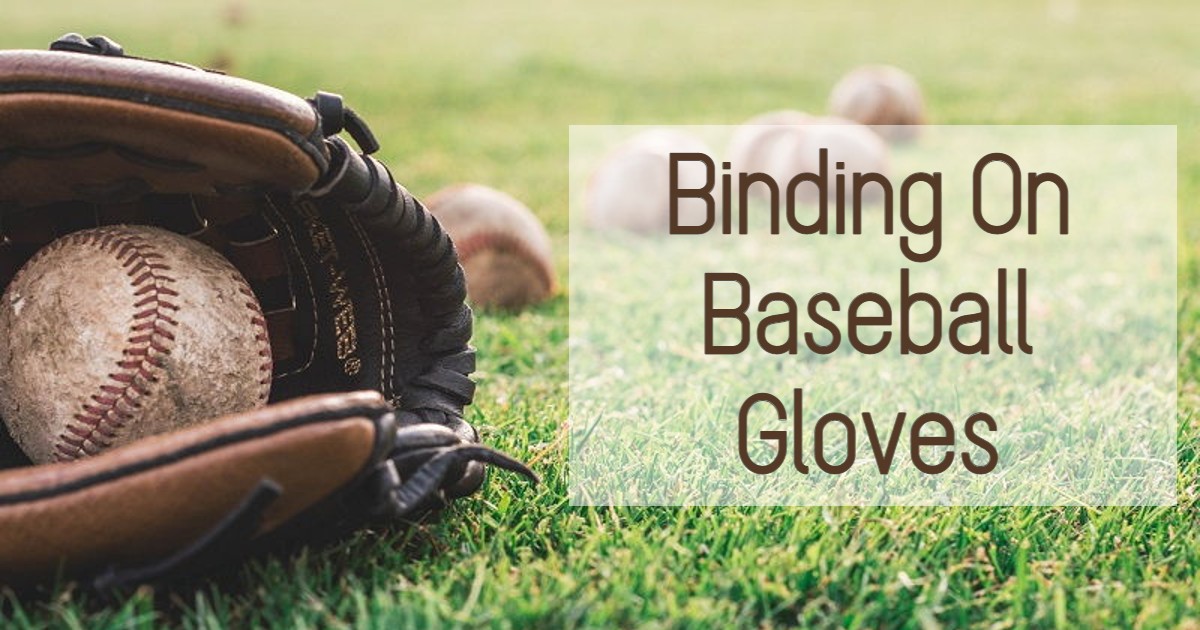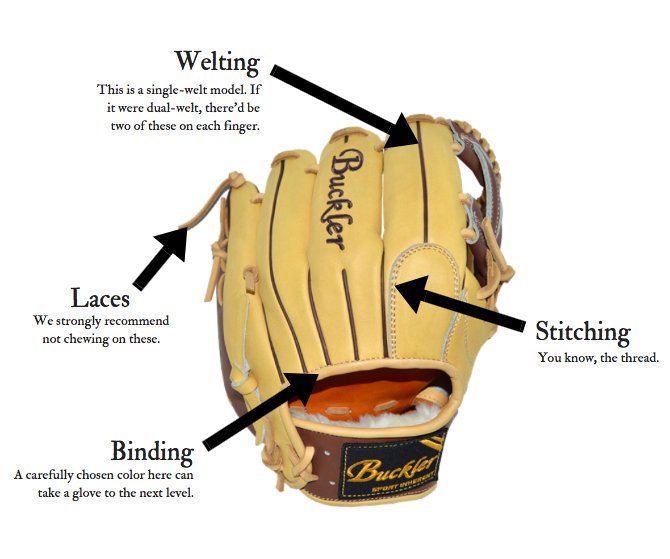Actually, a baseball glove, also known as a mitt, is an essential piece of equipment for any baseball player. But have you ever wondered what makes a baseball glove so special? Well, the answer lies in the binding. So, what is the binding on a baseball glove?
The binding on a baseball glove refers to the material that is used to secure the edges of the leather or synthetic material that makes up the glove. This binding can be made of a variety of materials, including leather, nylon, or even plastic.
It serves a couple of purposes, it reinforces the edges of the glove and protects it from wear and tear. It also adds a finished look to the glove and can come in a variety of colors and styles to match the design of the glove.
So, whether you’re a beginner or a baseball pro, don’t forget to pay attention to the binding when you’re picking out your next baseball glove. After all, a good binding can make or break your game, just like a bad joke can make or break a party. So keeping in mind all of your needs here, come up with a detailed guide about it.

Structural Reinforcement
Content Summery
One of the most important functions of it’s to reinforce the structure of the glove. The binding helps to hold the shape of the glove and provides support to the fingers and thumb, which allows the glove to maintain its form and function over time.
This is particularly important for gloves that are used frequently or in demanding conditions, as it helps to prevent the leather from becoming stretched or worn out. A well-bound glove maintains its shape and supports the fingers, which allows the player to catch and field the ball effectively.
Aesthetic Appeal
Another important function of the binding is to provide a finished appearance. It is often made from a contrasting material or color, which helps to accentuate the design of the glove and give it a polished look.
This is especially important for gloves that are used in competitive settings, as a well-bound glove can be seen as a sign of quality and attention to detail. Many professional male and female baseball players prefer gloves with bindings that match the color of their team or have a unique design.
Protection of Leather
In addition to its structural and aesthetic functions, the binding also serves to protect the edges of the leather from fraying. It covers the edges of the leather and prevents them from coming into contact with other surfaces, which can cause the leather to wear out or become damaged over time.
This is important for both the longevity of the glove and the safety of the player using it. Frayed edges on a baseball glove can cause discomfort to the player and also affect the performance of the glove.
Different Types of Binding
There are several types of bindings that are commonly used on baseball gloves, each with its own unique characteristics and benefits. Some of the most popular types of bindings include:
Leather bindings
These are considered to be the most durable and traditional options. They are made from high-quality leather and are known for their strength and durability. However, they can also be a bit stiff and less flexible than other materials.
Nylon bindings
These are more flexible and lightweight than leather bindings. They are often used on gloves designed for younger or less experienced players because of their flexibility and ease of use. However, they may not be as durable as leather bindings.
Plastic bindings
These are considered to be the most affordable option. They are often used on lower-priced gloves and are known for their durability and strength. However, they are not as flexible as leather or nylon bindings and may not last as long.
Synthetic bindings
These are made from synthetic materials such as polyester and are known for their durability and strength. They are also more flexible and lightweight than leather bindings.
Ultimately, the choice of binding depends on personal preference, position played, and the level of play. It’s important to consider all the options before making a final decision to find the binding that suits your needs best.
Binding Maintenance
To maintain the binding on your baseball glove, it is important to keep it clean and dry. Dirt and grime can cause it to become discolored and weaken the leather. When cleaning your glove, be sure to use mild soap and water and avoid using harsh chemicals.
Once the glove is clean, you should dry it thoroughly and apply a leather conditioner to help protect the leather. If the binding becomes frayed or damaged, it is important to get it repaired or replaced by a professional.
Binding Edge Replacement and Repair Cost
The cost of binding edge replacement and repair on a baseball glove can vary depending on several factors, such as the type of binding and the type of repair needed.
In general, the cost can range from around $20 to $50 for basic repairs, such as replacing a single binding edge, to $50 to $100 for more complex repairs, such as replacing multiple binding edges or repairing a tear or hole in the glove.
If you’re looking to replace the binding on your baseball glove, it’s important to consider the cost of the replacement material as well. Leather bindings are typically the most expensive option, while nylon and plastic bindings are more affordable.
The cost of the replacement material can range from around $10 to $25, depending on the quality and type of material used.
It’s also important to keep in mind that the cost of binding edge replacement and repair may vary depending on the location and the professional who is performing the repair.
Some baseball shops or sporting goods stores may offer repair services, while others may not. Some professional baseball glove makers also offer repair services.
In general, it’s important to shop around and compare prices before making a final decision on where to have your baseball glove repaired.
Additionally, if you have a very expensive or sentimental glove, it might be worth the cost to have it repaired by a professional with a good reputation to ensure the best results.
What is the Difference Between Rolled and Flat Binding on a Glove?
Rolled and flat binding are two different types of bindings that are used on baseball gloves. The main difference between the two is the way in which the binding is applied to the edges of the glove.
Rolled leather bindings
Rolled binding is applied by wrapping the binding material around the edges of the glove, creating a smooth, rounded edge. This type of binding is often used on gloves that are designed for younger or less experienced players because it provides a softer, more flexible edge that is easier to close and catch the ball with.
Flat leather bindings
Flat binding, on the other hand, is applied by attaching the binding material to the edges of the glove, creating a flat, straight edge. This type of binding is often used on gloves that are designed for more experienced players because it provides a firmer, more stable edge that is better for catching harder-hit balls.
In addition to the performance difference, rolled binding gives a more finished and polished look to the glove, while flat binding gives a more rugged and raw look.
Ultimately, the choice between rolled and flat binding depends on the player’s preference and skill level. Rolled binding is ideal for beginners or less experienced players who need more flexibility and control, while the flat binding is ideal for experienced players who need more stability and support.
Benefits of Binding on a Baseball Glove
There are several benefits of binding on a baseball glove, including:
- Reinforcing the edges of the glove and protecting it from wear and tear.
- Adding a finished look to the glove.
- Improving the overall performance and functionality of the glove.
- The binding can be made of different materials, providing a variety of options for durability, flexibility, and cost.
- Rolled binding gives a more finished and polished look to the glove, while flat binding gives a more rugged and raw look.
- The binding material can be chosen to match the design of the glove and the player’s preference.
- Different binding types and application methods can be chosen to fit the player’s skill level and position on the field.
- The binding can help to improve the grip and control of the glove during use.
- Helping the glove to keep its shape and form over time.
- It is also an important aspect in terms of the repair and maintenance of the glove.
Conclusion
In conclusion, the binding on baseball gloves serves as a crucial component that helps to secure the edges of the leather or synthetic material that makes up the glove.
It not only reinforces the edges of the glove, protecting it from wear and tear, but it also adds a finished look to the glove. Choosing the right binding material and application method can greatly affect the performance, durability, and overall look of the glove.

FAQs
Q. How does the binding on a baseball glove affect the performance of a glove?
The binding on a baseball glove helps to reinforce the structure of the glove, which allows the glove to maintain its shape and support the fingers and thumb. This is important for the overall performance of the glove, as it allows the player to catch and field the ball effectively.
Q. Can the binding on a baseball glove be repaired or replaced?
The binding on a baseball glove can be repaired or replaced if it becomes damaged or worn out. This is typically done by a professional leather worker or glove repair specialist.
Q. Are there different types of binding used on baseball gloves?
Yes, there are different types of binding used on baseball gloves, including leather, nylon, plastic, and synthetic bindings, each with its own unique characteristics and benefits. The choice of binding depends on personal preference, position played, and the level of play.
Q. What is flat binding on a baseball glove?
Flat binding is a type of binding in which the binding material is attached to the edges of the baseball glove, creating a flat, straight edge, providing a firmer and more stable edge for catching harder-hit balls.
